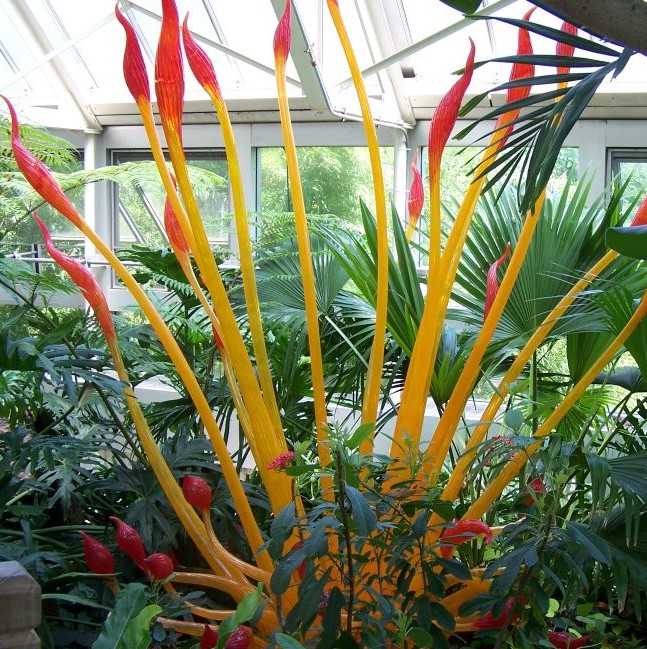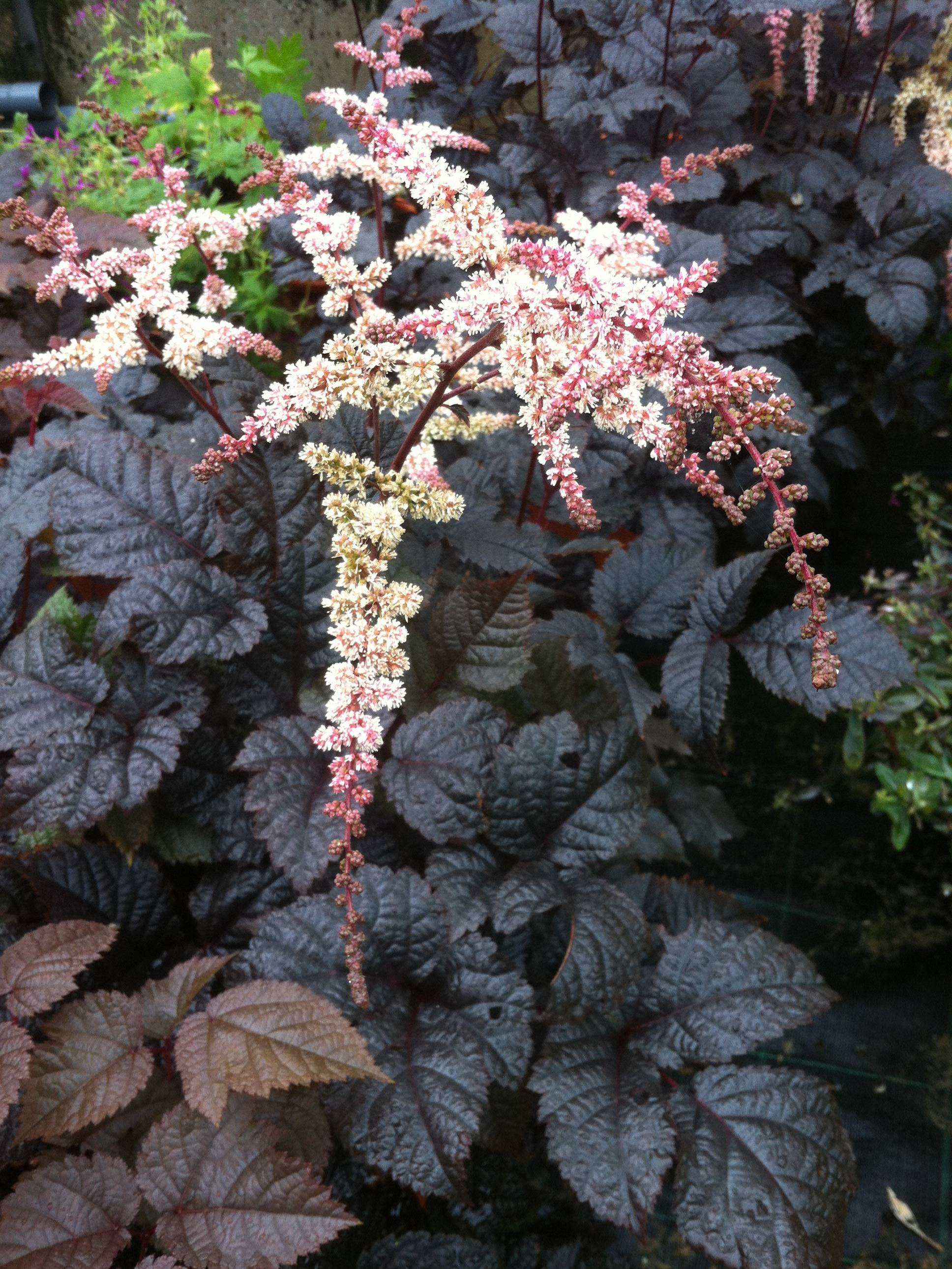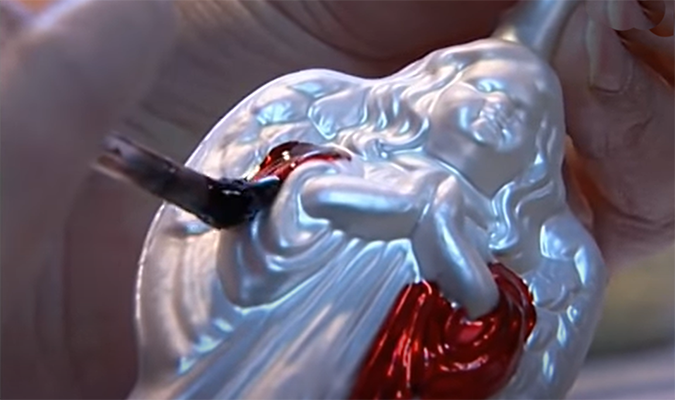Gardens are places where we can unleash our imagination and bring beauty into our everyday lives, transforming an ordinary space through the vibrant interplay of color, texture, and light. Plants alone can achieve a satisfying effect, but the addition of other materials such as stone, wood, metal, and glass can tremendously enhance the design. Glass garden art, in particular, has a unique ability to reflect light, enhance colors, and introduce a touch of magic to any outdoor space. Whether it's a functional or strictly decorative piece, glass garden art can provide just the artistic flair your garden needs.

Glass Garden Art - A Relatively Recent Innovation
Centuries ago, glass garden art did not exist, as glass was a purely practical element used for the protection of delicate plants in cloches and cold frames. By the Victorian era, glass had become a more widely used material in garden design, primarily through the advent of the glasshouse or conservatory. While these structures were functional in allowing for the cultivation of exotic plants, they could also be also places of great beauty and design, featuring elaborate glass walls, ceilings, and windows. The Victorians saw their gardens as an extension of their indoor spaces, and glass was the perfect material to merge the beauty of nature with architectural elegance.
As the Victorians embraced the idea of the garden as a space of leisure and beauty, they began using garden ornaments to adorn their landscapes. Among these ornaments was the gazing ball—a reflective glass sphere that added an element of mystery and intrigue to the garden. These decorative glass balls reflected the surrounding plants, trees, and sky, creating a shimmering, almost magical atmosphere. The use of glass in gardens, while still relatively rare, began to take on a more distinctly ornamental and artistic role.
Chihuly - The "Father" of Glass Garden Art
His spectacular glass sculptures, including the enormous and intricate "Chandeliers,", massive "Niijima Float" orbs, and spotted, speckled and streaked free-form "Macchia" were often inspired by organic forms like flowers, sea creatures, and natural landscapes, and brought blown glass into the realm of high art and public installations. The permanent outdoor installation of a Chandelier in 1996 ultimately led to a series of exhibitions and installations at arboretums, botanical gardens and conservatories world-wide that continue to this day.
Chihuly’s outdoor installations were revolutionary: glass, traditionally displayed in galleries, was instead integrated into natural landscapes--an entirely new and exciting concept. Whether placed amidst lush greenery and reflecting ponds or within an otherwise spare desert aesthetic, his works showcased the ability of glass to interact with natural light, creating an ethereal, ever-changing relationship between the glass pieces and their surroundings. These inspiring exhibits revealed that blown glass could be dynamic and organic, adding a sense of movement and vibrancy to any garden space. Thanks to Chihuly, blown glass was solidified as a legitimate art form in outdoor garden spaces, encouraging many other artists and designers to experiment with the medium.
Since then, the use of glass garden art has only continued to grow. Today, glass is found in gardens of all types, from formal to whimsical to wild. The evolution of glass as a medium for outdoor decor has led to a broader acceptance of glass as a primary material in garden design.


Design Elements and Ideas for Using Glass Art in the Garden
Incorporating glass garden art into your design requires careful thought, as glass decor works best when balanced with the natural elements around it. Here are some things to consider when introducing glass to your outdoor space:
Shapes of Glass and Their Design Impact
Geometric Shapes
- Design Impact: Geometric shapes, like spheres, cubes, or angular sculptures, bring a modern or minimalist vibe to a garden. These shapes can create a striking contrast against the organic, flowing lines of plants and flowers.
- Best Uses: Glass gazing balls, glass pyramids, or abstract glass sculptures are ideal for contemporary or modern gardens, where clean lines and symmetry are central. The reflective nature of spherical gazing balls, for example, bounces light and colors around, creating a dynamic visual effect.
Organic Shapes
- Design Impact: Organic,flowing shapes (such as flowers, leaves, or waves) introduce a natural, whimsical, or even bohemian feel to the garden. These shapes often mimic the forms found in nature, adding a sense of harmony and fluidity.
- Best Uses: Blown glass flowers, spiraling sculptures, or whimsical animals can complement cottage-style and tropical gardens or containers. The soft, flowing lines of blown glass pieces look particularly stunning when intertwined with natural plant life.
Vertical Shapes
- Design Impact: Tall, thin glass pieces such as garden stakes or glass totems can add vertical interest and dimension to your garden. These shapes can direct
the eye upward, highlighting the height and layers of your garden space. - Best Uses: Use blown glass garden stakes or solid glass sculptures to create focal points along walkways, in flower beds, or near water features. These pieces can also help draw attention to specific areas or plants, acting as both markers and decorative accents.
Glass Colors and Their Visual Effects
Clear Glass
- Design Impact: Clear glass creates a clean, minimalist look that allows the surrounding plants and flowers to shine. It reflects light beautifully, creating subtle glimmers throughout the garden.
- Best Uses: Clear glass gazing balls, glass vases, or transparent garden lanterns can be used in any garden to enhance the natural beauty of plants. Clear glass is especially striking when paired with colorful flowers, reflecting and amplifying their hues.
- Color Pairing: Since clear glass acts as a neutral, it pairs well with bold or brightly colored plants and flowers, allowing the garden’s flora to take center stage
while the glass decor adds texture and sparkle. It can also add subtle elegance to textural mixes of green foliage, especially in shaded gardens.
Frosted Glass
- Design Impact: Frosted glass has a soft, muted appearance, which works well in creating a more gentle, calming ambiance. It diffuses light, adding a gentle glow to the space, especially when lit from within or behind. Frosted glass works particularly well with geometrics because the simplicity of the glass allows the shape itself to take center stage, enhancing the form without competing with bright colors.
- Best Uses: Frosted glass lanterns, water features, or gazing balls are great for creating soft lighting effects in shaded or evening garden spaces. Frosted glass is especially effective in Zen gardens or tropical settings, where a tranquil, reflective atmosphere is desired.
- Color Pairing: The softness of frosted glass complements pastel-colored plants or soft green or silver foliage, creating a serene, ethereal look. Frosted glass works particularly well with geometric shapes because the simplicity of the glass allows the shape itself to take center stage, enhancing the form without competing with bright colors.
Vibrant Colors (Red, Orange, Yellow, etc.)
- Design Impact: Bold, vibrant colors can inject energy and drama into your garden design, adding life and intensity to the landscape. Warm tones work well when you want to evoke energy and movement in the garden.
- Best Uses: Blown glass flowers, decorative glass spheres, and hummingbird feeders in bright colors are perfect for flower gardens, butterfly gardens, or any space you want to bring a playful, eye-catching focal point to.
- Color Pairing: Pairing vibrant glass decor with complementary or contrasting colors in your plants can create visual excitement. For example, yellow glass looks beautiful against deep purple flowers, while red glass pairs well with lush greenery.
- Cool Tones (Green, Blue, Purple)
- Design Impact: Cooler tones (like blues, purples, and greens) are great for creating a more serene, relaxed, or subtle and sophisticated atmosphere.
- Best Uses: Particularly effective when used for a water feature, whether a bird bath, fountain, or pond float.
- Color Pairing: These tones are softly beautiful blended with silver and green foliage. Purple glass can be an effective foil against chartreuse foliage.
Metallic and Iridescent Glass
- Design Impact: Metallic or iridescent glass pieces add a touch of glamour and sophistication to your garden. These pieces reflect light in unique ways, changing color depending on the angle of the sun, creating a magical, shifting effect.
- Best Uses: Iridescent gazing balls, metallic glass planters, and reflective glass sculptures are ideal for creating a luxurious focal point or statement piece. These pieces work well in formal gardens, Mediterranean-style gardens, or modern outdoor spaces. Mirrors mounted on a wall or fence can make a small space look larger.
- Color Pairing: Iridescent glass looks stunning in dappled sunlight, particularly in gardens with neutral-colored stone or dark foliage, where the glass can truly catch the light and create a shimmering effect.
Chihuly’s Style and Philosophy in Garden Installations
Interaction with Natural Light
One of Chihuly’s main innovations in his garden installations is how his glass pieces interact with natural light. His sculptures often reflect,refract, and transmit light, creating shifting colors and patterns depending on the time of day. The idea of light and glass as a living, changing entity was central to his vision of outdoor installations. Look for opportunities for backlighting, uplighting, and downlighting in conjunction with the sun's path during the day and any nighttime landscape lighting.
Integration with the Landscape
Unlike traditional gallery pieces, which are often displayed on pedestals or confined to a static location, Chihuly’s works are immersive. He designs installations to fit harmoniously with the contours and features of the garden itself -- whether that’s surrounding plants, water features, or other landscape elements. His glass installations create dynamic visual experiences that change with the seasons, weather, and light. As with any good garden design, all four seasons should be considered. Glass art can add interest to beds or borders when plants are dormant for winter, or direct the eye away from diminishing bulb foliage in spring. Perhaps move a piece with the seasons for best effect.
Organic Forms and Color
Chihuly's glass art often mimic forms found in nature -- flowers, sea creatures, and organic shapes. His pieces are designed to evoke the fluidity and whimsy of nature, often using vivid colors like reds, yellows, and blues that capture the eye and create a striking contrast with the greenery around them. These can be just the thing for dark, shaded spots or garden areas heavy on evergreens or plants that are out of bloom.
Large Scale and Dramatic Presence
Chihuly's installations are often large and ambitious, creating dazzling focal points in the landscape. Whether it’s a towering glass chandelier, a series of floating glass sculptures in a pond, or an entire garden filled with colorful glass flowers, his installations command attention and draw visitors into a sensory experience that’s unlike any other. While displays on such a scale would be impractical for the average garden, groupings of glass ornaments or repeated shapes or colors of glass accents throughout the landscape can be used to spectacular effect.

Types of Glass for Garden Decor
There are several forms of glass typically found for outdoor use. Most outdoor items are made from soda lime glass, the typical glass used for drinkware and other decorative objects. In general, thicker glass withstands the elements better.
Blown Glass
Blown glass objects, such as sculptures, globes, and flowers, create eye-catching focal points. These pieces are often lightweight yet sturdy, making them ideal for gardens. Many people don't realize that good quality blown glass garden art can be left outdoors year round. One of our artisans has had several of his creations outdoors at his own home for over 15 years -- well-made pieces are much less delicate than folks suppose.
Colored blown glass can be opaque or translucent. Opaque glass has a stronger and more concentrated color impact, while translucent glass colors create a gentler effect. Some pieces will have an intriguing mixture of both. These qualities do not affect the sturdiness of the glass itself.
Stained Glass
Stained glass brings a touch of old-world charm to gardens. Whether in the form of window panels, hanging ornaments, or garden panels, stained glass can transform sunlight into a dazzling array of colors, adding drama and depth to your space. It may also be used in mosaic form on gazing balls and statuary.
Fused Glass
Fused glass is made by melting together different pieces of glass, often to create intricate designs. These glass pieces are durable and can be used to make everything from garden stakes to decorative tiles. The beauty of fused glass is in its ability to hold both delicate and bold designs.
Care and Maintenance of Glass Decor
Glass garden decor may be beautiful, but it does require some attention to keep it in top shape. Here are some essential care tips:
- Cleaning: Regular cleaning is key to maintaining the shine and clarity of glass decor. Use a soft cloth and a mixture of mild dish soap and water. For stubborn stains,
vinegar can help break down mineral deposits. - Protection from the Elements: In areas with predictable snow accumulation, glass garden art should be removed and stored for winter to avoid breakage during snow removal. Under no circumstances should outdoor glass be left holding water in cold climates -- the water may freeze and crack the glass.
Glass Art For Your Garden
- Glass Garden Stakes: These are perfect for adding pops of color or vertical interest, to both beds and containers. Strategically place them amidst your greenery for a striking focal point. We also offer the Water Tulip, a decorative blown glass vessel on a hollow copper stake that aids in deep watering your house or garden plants.
- Glass Water Features: A glass fountain, butterfly feeder, or birdbath brings a touch of sophistication to your garden while providing soothing sounds and attracting wildlife.
- Blown Glass Hummingbird Feeders: These pieces have become beloved by gardeners for their dual purpose -- providing food for birds while adding vibrant color and a delicate, artistic touch to gardens. Their lightweight and translucent nature makes them ideal for hanging in trees and shrubs or from shepherd hooks, and those with metal stakes can be used in containers of virtually any size or shape, including window boxes.
- Glass Pond Floats: Once used by fishermen to mark nets, glass floats now serve as striking decorative elements in water gardens or ponds. Their reflection in the water creates a serene, peaceful effect. They can also add a charming pop of color to container gardens, beds, and borders. The glass is completely sealed so water cannot enter.
- Glass Lanterns: The soft glow of glass lanterns or tea light holders adds ambiance to evening garden gatherings and colorful accents in daytime.
- Gazing Balls and Spheres: These classic garden pieces have experienced a resurgence in popularity, thanks in part to the bright colors and intricate designs available in modern blown glass. They serve as focal points and reflective elements in garden design, drawing attention to plants or other features. These are usually set on an attractive stand or pedestal.
- Colorful Glass Ornaments: Hanging glass baubles, globes, or birdfeeders in trees adds sparkle and color. Choose shades that complement the plants and flowers in
your garden to create a cohesive look.
Where to See Chilhuly's Permanent Garden and Outdoor Displays
Chihuly Garden and Glass, Seattle Center, Seattle Washington
Denver Botanic Gardens, Denver, Colorado: Large "Colorado" Sculpture in Ellipse Garden
Atlanta Botanical Garden, Atlanta, Georgia: Three large sculptures including a fountain, an icicle tower, and a nepenthes chandelier


















